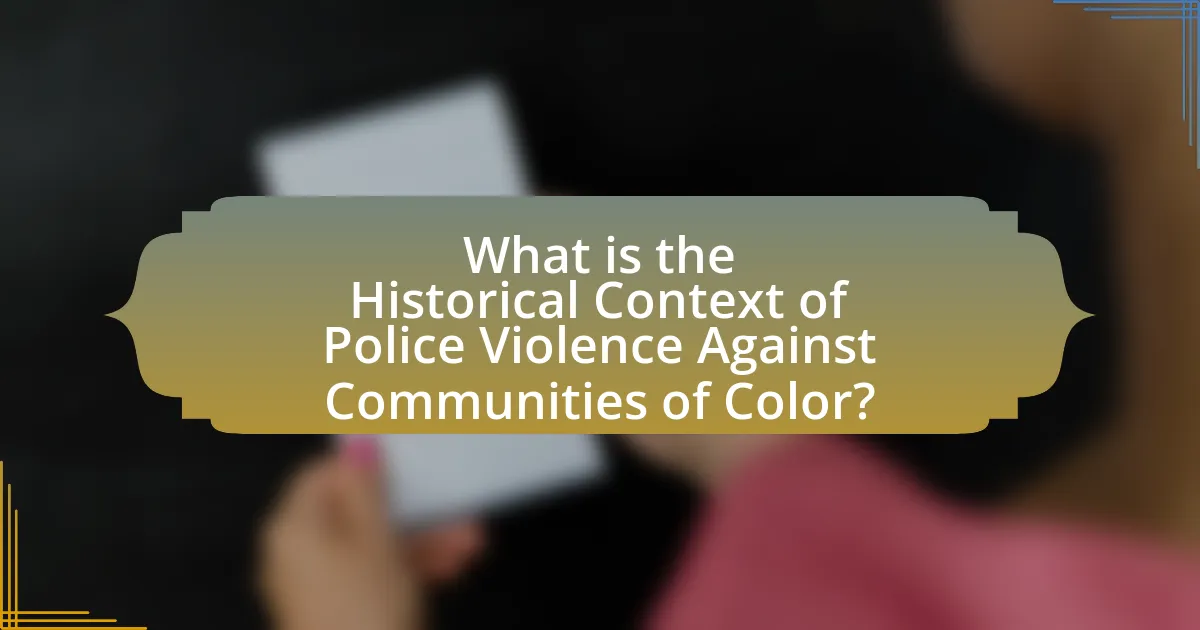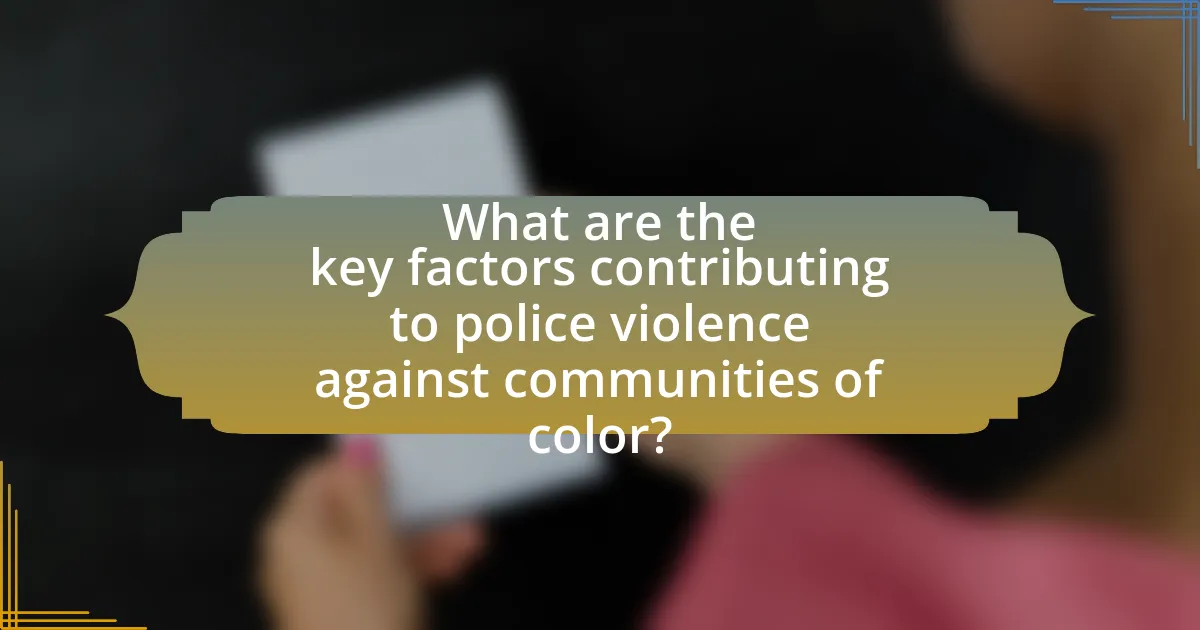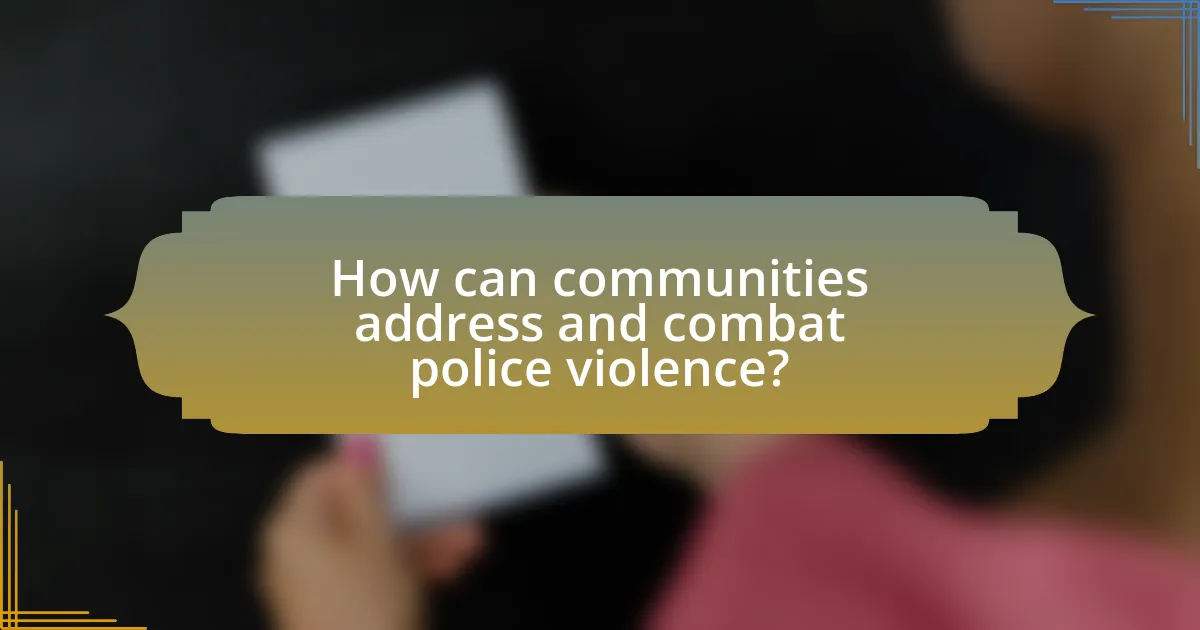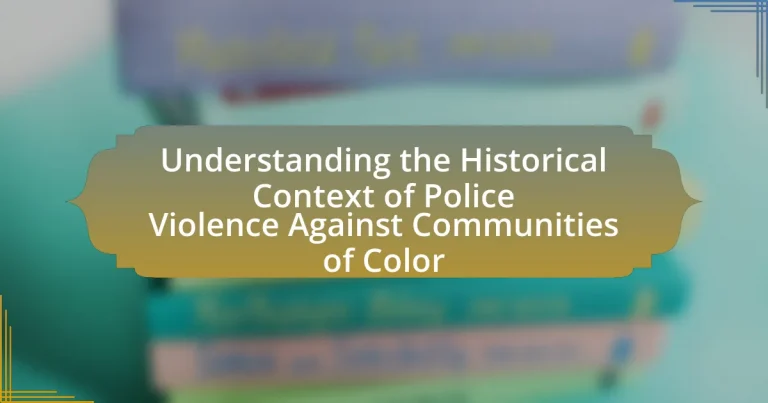The article examines the historical context of police violence against communities of color, highlighting its roots in systemic racism and social control mechanisms. It traces the evolution of police violence from the era of slavery and Jim Crow laws to contemporary incidents, emphasizing the disproportionate impact on Black individuals. Key historical events, such as the Civil Rights Movement and the Black Lives Matter movement, are discussed in relation to their influence on police-community relations. The article also explores how laws and policies have shaped police violence, the role of socio-economic factors, and the importance of understanding this context for addressing current issues of police brutality and advocating for reform.

What is the Historical Context of Police Violence Against Communities of Color?
The historical context of police violence against communities of color is rooted in systemic racism and the enforcement of social control. From the era of slavery in the United States, where slave patrols were established to control enslaved populations, to the Jim Crow laws that enforced racial segregation, law enforcement has often acted as an instrument of oppression against people of color. For example, the 1960s Civil Rights Movement highlighted numerous instances of police brutality against African Americans, as seen in events like the Birmingham campaign, where police used violent tactics against peaceful protesters. Additionally, studies indicate that Black individuals are disproportionately affected by police violence, with data showing that they are three times more likely to be killed by police than white individuals. This historical pattern illustrates a continuity of violence and discrimination that persists in contemporary policing practices.
How has police violence evolved over time in relation to communities of color?
Police violence against communities of color has evolved significantly over time, marked by systemic racism and changing societal attitudes. Historically, during the era of slavery and Jim Crow laws, law enforcement often enforced racial segregation and violence against Black individuals, exemplified by lynchings and brutal policing practices. In the 1960s, civil rights movements highlighted police brutality, leading to increased scrutiny and calls for reform. However, incidents such as the 1991 beating of Rodney King and the subsequent riots in Los Angeles underscored persistent issues of police violence. More recently, high-profile cases like the killings of Michael Brown and George Floyd have sparked nationwide protests and a renewed focus on systemic racism within policing. Data from the Mapping Police Violence project indicates that Black individuals are disproportionately affected by police killings, accounting for 28% of those killed by police in 2020, despite representing only 13% of the U.S. population. This evolution reflects ongoing struggles for justice and accountability in law enforcement practices.
What historical events have significantly impacted police-community relations?
The historical events that have significantly impacted police-community relations include the Civil Rights Movement, the Watts Riots of 1965, and the Black Lives Matter movement. The Civil Rights Movement highlighted systemic racism and police brutality, leading to increased scrutiny of law enforcement practices. The Watts Riots were a response to police violence against African Americans, resulting in a national conversation about race relations and policing. The Black Lives Matter movement, which began in 2013, has further amplified issues of police violence against communities of color, leading to widespread protests and calls for reform. These events collectively illustrate the ongoing tensions and challenges in police-community relations, particularly in marginalized communities.
How have laws and policies shaped the nature of police violence?
Laws and policies have significantly shaped the nature of police violence by establishing frameworks that govern police conduct and accountability. For instance, the “War on Drugs” policies enacted in the 1980s led to increased militarization of police forces and aggressive policing tactics, disproportionately affecting communities of color. Additionally, qualified immunity laws protect officers from civil liability, which can perpetuate a culture of impunity and reduce accountability for excessive use of force. Historical legislation, such as the Violent Crime Control and Law Enforcement Act of 1994, further entrenched practices that have resulted in systemic violence against marginalized groups. These laws and policies create an environment where police violence can escalate without sufficient checks and balances, thereby influencing the overall dynamics of law enforcement interactions with communities of color.
Why is understanding this historical context important?
Understanding the historical context of police violence against communities of color is crucial because it reveals the systemic roots and patterns of discrimination that have persisted over time. This context illustrates how historical injustices, such as slavery, segregation, and discriminatory laws, have shaped contemporary policing practices and community relations. For instance, the legacy of the Civil Rights Movement highlights the ongoing struggle against institutional racism, which informs current debates on police reform and accountability. Recognizing these historical factors enables a more informed dialogue about present-day issues, fostering a deeper understanding of the complexities involved in addressing police violence and advocating for equitable solutions.
How does historical context inform current perceptions of police violence?
Historical context significantly shapes current perceptions of police violence by highlighting patterns of systemic racism and abuse that have persisted over time. For instance, the legacy of slavery and segregation in the United States has fostered mistrust between law enforcement and communities of color, as evidenced by historical events such as the 1965 Watts riots and the 1992 Los Angeles riots, both triggered by police violence against Black individuals. Additionally, studies indicate that Black Americans are disproportionately affected by police violence, with data showing that they are three times more likely to be killed by police than white Americans. This historical backdrop informs contemporary discussions about police reform and accountability, as it underscores the need to address ingrained biases and institutional practices that perpetuate violence against marginalized communities.
What lessons can be learned from past incidents of police violence?
Past incidents of police violence reveal critical lessons about the need for systemic reform and accountability within law enforcement agencies. Historical patterns demonstrate that a lack of oversight often leads to repeated abuses, as seen in cases like the 1991 beating of Rodney King, which sparked widespread protests and highlighted the urgent need for police accountability measures. Furthermore, data from the Mapping Police Violence project indicates that Black individuals are disproportionately affected by police violence, underscoring the necessity for targeted training and community engagement to address racial biases. These lessons emphasize the importance of implementing comprehensive policies that promote transparency, community relations, and the protection of civil rights to prevent future incidents of violence.

What are the key factors contributing to police violence against communities of color?
Key factors contributing to police violence against communities of color include systemic racism, socioeconomic disparities, and inadequate police training. Systemic racism manifests in biased policing practices and policies that disproportionately target communities of color, leading to higher rates of violence. Socioeconomic disparities, such as poverty and lack of access to education, exacerbate tensions between law enforcement and these communities, often resulting in confrontations. Additionally, inadequate police training on de-escalation techniques and cultural competency can lead to misunderstandings and excessive use of force. Research indicates that Black individuals are three times more likely to be killed by police than white individuals, highlighting the urgent need to address these factors.
How do systemic racism and socio-economic factors play a role?
Systemic racism and socio-economic factors significantly contribute to police violence against communities of color by perpetuating inequality and marginalization. Systemic racism manifests through institutional practices and policies that disproportionately target racial minorities, leading to higher rates of police encounters and violence. For instance, studies show that Black individuals are three times more likely to be killed by police than white individuals, highlighting the impact of racial bias in law enforcement.
Moreover, socio-economic factors such as poverty, lack of access to quality education, and unemployment exacerbate these disparities. Communities of color often face systemic barriers that limit their economic opportunities, which can lead to higher crime rates and increased police presence. According to the Economic Policy Institute, Black workers are more likely to be unemployed and earn lower wages compared to their white counterparts, creating a cycle of disadvantage that fuels tensions with law enforcement.
Together, systemic racism and socio-economic factors create an environment where police violence is more prevalent, as marginalized communities are subjected to heightened scrutiny and aggression from law enforcement.
What evidence exists to support the link between systemic racism and police violence?
Evidence supporting the link between systemic racism and police violence includes statistical disparities in police encounters and use of force against racial minorities. Research indicates that Black individuals are disproportionately subjected to police violence, with studies showing that they are three times more likely to be killed by police than white individuals. A report by the Mapping Police Violence project in 2020 highlighted that Black people accounted for 28% of those killed by police, despite representing only 13% of the U.S. population. Additionally, systemic issues such as racial profiling and discriminatory policing practices have been documented in various studies, including the 2013 report by the U.S. Department of Justice on the Ferguson Police Department, which revealed patterns of racial bias in law enforcement practices. These findings collectively illustrate how systemic racism manifests in policing, leading to increased violence against communities of color.
How do socio-economic disparities affect community-police interactions?
Socio-economic disparities significantly affect community-police interactions by creating mistrust and tension between law enforcement and marginalized communities. Research indicates that lower socio-economic status often correlates with higher crime rates, leading to increased police presence and surveillance in these areas, which can foster feelings of alienation and hostility among residents. For example, a study by the Brennan Center for Justice found that communities with higher poverty rates experience more aggressive policing tactics, which can escalate conflicts and reduce cooperation with law enforcement. Additionally, socio-economic disparities can limit access to resources such as legal representation and community support, further complicating interactions and perpetuating cycles of distrust.
What role does media representation play in shaping public perception?
Media representation significantly influences public perception by framing narratives and shaping societal attitudes towards specific groups. For instance, studies show that the portrayal of communities of color in news media often emphasizes crime and violence, which can lead to increased public fear and bias against these communities. Research conducted by the American Psychological Association indicates that negative media portrayals contribute to stereotypes that affect how individuals perceive and interact with people from these backgrounds. This framing can perpetuate systemic racism and impact policy decisions, as public opinion is often swayed by the narratives presented in media outlets.
How has media coverage influenced the narrative around police violence?
Media coverage has significantly shaped the narrative around police violence by amplifying incidents and framing public perception. High-profile cases, such as the deaths of George Floyd and Breonna Taylor, received extensive media attention, leading to widespread protests and calls for reform. This coverage often highlights systemic issues within law enforcement, influencing public discourse and policy discussions. Research indicates that media portrayal can affect public opinion; for instance, a study by the Pew Research Center found that 61% of Americans believe media coverage of police violence has increased awareness of racial disparities in policing. Thus, media coverage plays a crucial role in shaping societal understanding and responses to police violence.
What impact does social media have on awareness and activism regarding police violence?
Social media significantly enhances awareness and activism regarding police violence by providing a platform for real-time information sharing and mobilization. The rapid dissemination of videos and personal accounts of police encounters, particularly those involving communities of color, has led to increased public scrutiny and outrage. For instance, the viral spread of the video showing George Floyd’s death in 2020 catalyzed global protests and discussions about systemic racism and police brutality. Research by the Pew Research Center indicates that 69% of Americans believe social media is an important tool for activism, highlighting its role in organizing protests and raising funds for related causes. This digital engagement fosters community solidarity and amplifies marginalized voices, ultimately influencing policy discussions and reforms.

How can communities address and combat police violence?
Communities can address and combat police violence by implementing community-led oversight boards that monitor police conduct and establish accountability measures. These boards can provide a platform for community members to voice concerns, review incidents of police violence, and recommend policy changes. Research indicates that cities with independent oversight bodies have seen a reduction in police misconduct; for example, a study by the National Institute of Justice found that such oversight can lead to improved police-community relations and decreased instances of excessive force. Additionally, communities can engage in advocacy for policy reforms, such as the implementation of de-escalation training for officers and the reallocation of police funding towards social services, which has been shown to reduce reliance on police intervention in non-violent situations.
What strategies have been effective in advocating for police reform?
Effective strategies for advocating for police reform include grassroots organizing, coalition building, and leveraging social media campaigns. Grassroots organizing mobilizes community members to demand accountability and transparency from law enforcement, exemplified by movements like Black Lives Matter, which gained traction through local protests and community engagement. Coalition building among diverse groups, including civil rights organizations, faith-based communities, and local activists, has proven effective in amplifying voices and creating a unified front for reform. Additionally, social media campaigns have played a crucial role in raising awareness and mobilizing support, as seen in the viral spread of videos documenting police violence, which have prompted public outcry and legislative action. These strategies collectively contribute to sustained pressure on policymakers to implement meaningful reforms.
How can community engagement lead to better policing practices?
Community engagement can lead to better policing practices by fostering trust and collaboration between law enforcement and the communities they serve. When police departments actively involve community members in decision-making processes, they gain valuable insights into local issues, which can inform more effective policing strategies. For example, research conducted by the National Institute of Justice found that community policing initiatives, which emphasize partnerships with community members, resulted in a 20% reduction in crime rates in participating neighborhoods. This collaborative approach not only enhances public safety but also promotes accountability and transparency within police practices, ultimately leading to improved relations and reduced tensions between law enforcement and communities of color.
What role do grassroots movements play in addressing police violence?
Grassroots movements play a crucial role in addressing police violence by mobilizing communities, raising awareness, and advocating for policy changes. These movements often emerge in response to incidents of police brutality, uniting individuals to demand accountability and reform. For example, the Black Lives Matter movement, which gained prominence after the killing of Trayvon Martin in 2012, has significantly influenced public discourse and policy regarding police violence against communities of color. Research indicates that grassroots activism can lead to legislative changes, such as the introduction of body cameras for police officers and the implementation of community oversight boards, which aim to increase transparency and accountability in law enforcement practices.
What resources are available for communities affected by police violence?
Communities affected by police violence can access various resources, including legal aid organizations, mental health services, community support groups, and advocacy organizations. Legal aid organizations, such as the American Civil Liberties Union (ACLU), provide legal representation and advice to victims of police misconduct. Mental health services, like the National Alliance on Mental Illness (NAMI), offer support for trauma and emotional distress resulting from police violence. Community support groups, such as local grassroots organizations, facilitate healing and empowerment through collective action. Advocacy organizations, including Black Lives Matter, work to raise awareness and push for policy changes to address systemic issues related to police violence. These resources collectively aim to support affected communities in seeking justice and healing.
How can community organizations support victims of police violence?
Community organizations can support victims of police violence by providing legal assistance, mental health services, and advocacy for policy changes. These organizations often offer resources such as legal representation to help victims navigate the justice system, which is crucial given that studies indicate that victims of police violence frequently face barriers in seeking justice. Additionally, mental health support is vital, as research shows that exposure to police violence can lead to long-term psychological trauma. Furthermore, community organizations can mobilize advocacy efforts to push for systemic reforms, as evidenced by movements that have successfully influenced legislation aimed at police accountability.
What legal resources are available for individuals facing police misconduct?
Individuals facing police misconduct can access several legal resources, including civil rights organizations, legal aid services, and private attorneys specializing in police misconduct cases. Civil rights organizations, such as the American Civil Liberties Union (ACLU) and the NAACP Legal Defense Fund, provide legal assistance and advocacy for victims of police abuse. Legal aid services offer free or low-cost legal representation to those who qualify based on income. Additionally, private attorneys with experience in civil rights law can help individuals file lawsuits against police departments for violations of constitutional rights. These resources are crucial for ensuring accountability and seeking justice in cases of police misconduct.
What are some best practices for fostering positive police-community relations?
Best practices for fostering positive police-community relations include community engagement initiatives, transparency in operations, and accountability measures. Community engagement initiatives, such as regular town hall meetings and collaborative problem-solving sessions, allow police to build trust and understand community concerns. Transparency in operations, including the public sharing of data on police activities and use of force, fosters trust and reduces suspicion. Accountability measures, such as independent oversight boards and clear protocols for addressing misconduct, ensure that police actions are held to high standards, reinforcing community confidence in law enforcement. These practices have been shown to improve perceptions of police legitimacy and reduce tensions, as evidenced by studies indicating that communities with active police engagement report higher satisfaction with law enforcement services.

